How we get more output from our subs
Most subwoofers on the market are horrendously inefficient. Many need extreme power amplifiers to overcome this problem. Many are impressed at first with subwoofers which use kilowatts of power, thinking they must have extreme output. In reality, our sensibly powered and intelligently designed subwoofers will achieve the same output (if not more) with greater accuracy and less cost.
Please note: When this article was written we were selling Linkwitz Transform (LT) subwoofer kits. These are now discontinued. We recommend our Custom Install subwoofers as they are a superior range.
Efficiency - removing compromises by intelligent design
If you have decided to build a sealed box sub, we strongly recommend you avoid the mistake of building yet another sub that is based on obsolete fifty year-old methods to achieve good bass extension. Instead, use an up to date technology like Direct Servo or Linkwitz Transform (LT). Both are simply better ways to design a sealed subwoofer.
"What’s wrong with the old method?"
Old methods are based on limitations that technology has now overcome. Fifty years ago, amplifiers (and electronic components in general) were expensive, not to mention that fancy design tricks such as LT equalization and servo feedback were not available. Therefore the objective was to achieve flat response without equalization, with minimal electronics cost. That often meant a large enclosure and a small amplifier. At the same time, there were no home theaters, so designers didn't expect users to crank up the volume and cause the amplifier to clip or worse, the driver to bottom out. As a result, often the excursion plots were not carefully studied.
Technology has redefined the question
Since then, technology has made new choices possible. High power amplifiers are now affordable. With inexpensive servo and LT circuits available, it is time to think differently. The question today is how to build a sealed box with higher useable output without causing the driver to exceed its excursion limits.
Our approach is very simple. We use a medium-to-high Q excursion curve and low Q frequency response.
Getting more output from the same driver
In a constant-voltage-drive configuration (without any equalization), a higher Q value in the bass extension creates a boomy sound. The reason is very simple. A higher Q bass extension is more efficient in the pass band and therefore generate more bass energy. In other words, with the same input to the subwoofer driver, a higher Q alignment can push the subwoofer driver to put out more energy. This is one physical phenomenon that we can definitely take advantage of in order to get more bang-for-the-buck out of our drivers. The trick is however, not to let this high Q characteristic get into frequency response curve, as a lower Q frequency response achieves greater definition.
With conventional constant-voltage-drive technology, the maximum output curve and frequency response curves are identical. Our technology enables each curve to be individually optimized, so that we get the best of both worlds combined into one design.
Excursion utilization
The excursion utilization is defined as the percentage of this 12mm maximum that the driver can achieve without the amplifier clipping. In the following discussion, we will assume the maximum allowed excursion at 5 Hz is 12mm and the amplifier does not have any equalization. All excursion plots will also be called maximum excursion plot, because that is the maximum excursion one can get without the amp clipping.
The first maximum excursion plot is for a case with corner frequency of 20 Hz and Q value of 0.7. We can see the excursion utilization at 20 Hz is only 75%. At 30 Hz, it is only 40% whereas at 40 Hz, it drops to only 25%. The important implication here is that at 30 Hz, the amp will begin to clip when the excursion reaches only 5mm. That means the listener will begin to hear the clipping distortion from the amplifier when the driver is still within a fairly linear excursion range. At 40 Hz, the amp will begin to clip when the excursion reaches 3 mm. A lot of subwoofer builders have ignored this important issue. The secret of getting more output does not end with a driver with high excursion capability. As shown here, the excursion plots determine how well the excursion capability is realistically realized.
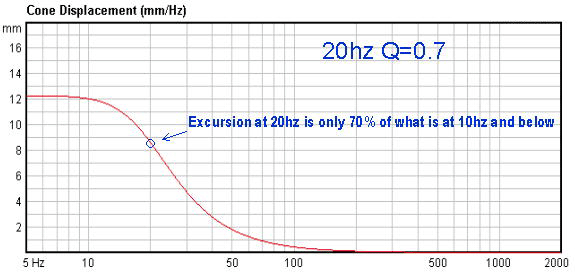
Fig 1.0 -Excursion plot - Q = 0.7
The above chart shows the excursion plot for a typical sealed subwoofer. It shows how the excursion capability of the driver is not well used.
If we look at the so-called low Q alignment (such as Infinite Baffle, dipole subs, or large sealed boxes), we will get even lower excursion utilization as shown below, only achieving 50% excursion utilization at 20 Hz and less than 30% at 30 Hz. This poor excursion utilization explains why it is so easy for IB subs to bottom out (exceed their maximum excursion). The poor excursion utilization (and therefore lower output) prompts the user to turn up the volume, without knowing that the amp is already clipping. When the amp clips, it generates clipping distortion that is not in the amplifier input signal. The rumble filter has no effect at all. Furthermore, the spectral contents of this clipping distortion are very difficult to predict. If the clipping occurs only momentarily, the spectral contents are most likely at higher frequency ranges. However, when the amp goes into prolonged clipping, the spectral contents begin to shift to lower frequencies. When they begin to reach frequencies below 5 Hz where the excursion hotspot resides, they cause the driver to bottom out.
So we can see that the design of a sealed sub is not as simple as getting a driver with big excursion capability and designing the box for optimal frequency response. The maximum excursion curve is a very good indicator of how the driver's excursion potential is put to use.
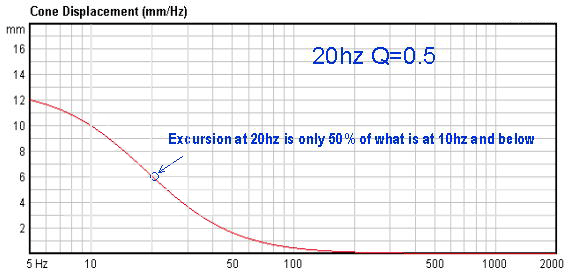
Fig 1.1 -Excursion plot - Q = 0.5
The above chart shows the excursion plot for a low Q sealed subwoofer. The situation is even worse than the previous chart.
Our goal with Direct Servo and LT is to produce a maximum excursion curve like the one shown below. The driver maintains a flat maximum excursion utilization from 5 Hz all the way to 30 Hz. Even at the 40 Hz, the excursion is still at a good 10 mm. This higher excursion utilization requires less power to achieve the same excursion between 20 - 80 Hz when compared to the previous two cases. The extra power can be used elsewhere to achieve more bass.
So what is the corner frequency and Q value of this excursion curve? The answer is fs=40 Hz and Q=0.9. Normally this would require a smaller enclosure and a large amplifier.
Our customers have often found our subwoofers to play louder than they had expected. The explanation is in the excursion plot. At 30-40 Hz, our subs are almost 200% more efficient than others. That is equivalent to using an amplifier with 9x the usable power, or over 3 kW!
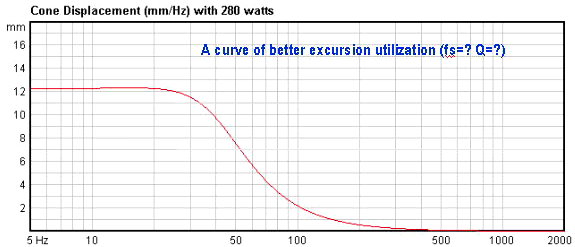
Fig 1.2 - ideal excursion plot
The above chart shows the ideal excursion plot in order to gain maximum efficiency.
The next big question is how much excursion we should set as our design goal when we select the proper amplifier and enclosure size? As we have explained earlier, in order to prevent the driver from bottoming out during amplifier clipping, we need to leave an adequate excursion margin as headroom. I recommend at least 40% of the mechanical maximum excursion limit as excursion headroom. For sealed subs, one can adjust enclosure size to limit the maximum excursion. However, one should not overdo it such that the Q value becomes larger than 1.3. Without violating this rule, a smaller enclosure will have higher excursion headroom. For Infinite Baffle and Dipole users, the only way to control the excursion headroom is amplifier power selection (to match the BL and Vas of the driver).
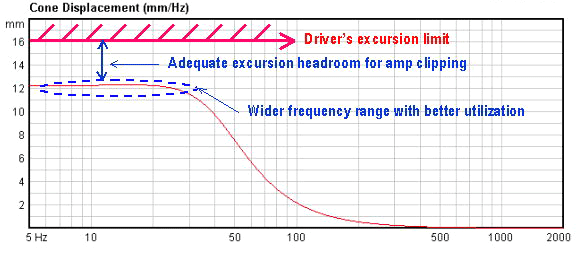
Fig 1.3 - excursion headroom plot
The above chart shows the recommended headroom allowance.
Below is the excursion plot of a sub where the enclosure is too small, so that the Q value becomes too high. The result is an excursion hot-spot, along with reduced low frequency output. This indicates that the enclosure is too small.

Fig 1.3 - excursion plot - undersized enclosure
The above chart shows the excursion when the enclosure is too small.
To summarize, we should follow the following two guidelines for servo subwoofers:
1. Avoid using an enclosure that is too small.
The smallest enclosure size one should use depends on the driver parameters. It is best to simulate the driver in the intended box using a box design software package that provides excursion plots. Avoid enclosure sizes that produce a plot as shown above. An enclosure that produces a plot like the one above will result in frequent bottoming of the woofer, without satisfactory low bass performance.
2. Always reserve a reasonable amount of excursion headroom.
This rule actually applies to all subwoofer designs. Avoid the temptation to attempt to use all of the excursion capability of the driver.
We all once in a while turn up the volume just a bit too high. Adequate excursion headroom can prevent the driver from bottoming out, even when the amplifier goes into clipping. To increase excursion headroom, we can reduce the enclosure size. In the case of an existing enclosure, we can place blocks of wood inside the enclosure.
How do Direct Servo subwoofers manage bass extension and Q value?
Servo subs become even more appealing if we add the flexible control of bass extension for the bass roll-off corner frequency and its Q value. For our A370 amps ordered with the LT add-on circuit board and our DS350 kit (now replaced with our CI range), the bass extension controls have 3 frequency settings (14 Hz, 20 Hz, 28 Hz) and 3 damping control setting (low, medium, and high which correspond to Q=0.9, Q=0.7, and Q=0.5, respectively). This allows for a sub with a low Q frequency response curve out of a small box. Those who like to tweak their systems for best results can experiment with these frequency and damping controls. Those who are building their first subwoofer would also have the chance to compare a variety of combinations of damping and corner frequency, given them a level of hands-on experience that usually only comes with several completed sub designs. And last but not least, the bass extension controls provide the opportunity to trade bass extension for maximum SPL, allowing one to play louder using the 28 Hz setting.
In the following discussion, we will see how adjusting enclosure size, moving mass, and amp size change the frequency response and excursion plot of a sealed box subwoofer. And finally, we will give an example of how to achieve better excursion utilization.
What do T/S Parameters Mean?
The best way to understand Thiele/Small parameters for sealed box subs is from the frequency response curve such as one shown above. The frequency response curve can be roughly divided into two regions. The green plateau region which is controlled by the cone mass (labeled as mass-controlled) and the blue roll-off region which is controlled by the stiffness from the driver and 'air spring' in the box combined (label as stiffness controlled). The roll-off follows a fixed 12db/oct slope. For each region, we also draw an asymptotic line, shown as green and blue dashed lines. The intersection of those two lines is the corner frequency of the bass roll-off. If one increases amp output, it will move the entire curve up.

Reducing cone mass by itself will move the mass-controlled region up (which essentially improves the efficiency in this region), while increasing cone mass will do the opposite. The above plot shows the comparison of lighter and heavier cone mass as compared with the original curve. We can see the corner frequency will move higher (lower) with reduced (increased) cone mass. While a lighter cone will move up the corner frequency of bass roll-off, sometimes it actually gives a more musical and dynamic sound (not because the lighter cone is "faster", but because lighter cone has lower distortion in the mass-controlled region). The heavier cone does achieve a lower corner frequency. However, the price to pay is dismal efficiency in the mass-controlled region. It is interesting to note that one relies on heavier cone weight to achieve 20 Hz bass extension, the required cone mass is around 600g for a typical 12" driver in 75L box. The efficiency at the mass-controlled region is as low as 75db/1m/1W. Even if one only needs 28 Hz extension, it still requires a hefty 300g cone mass (81db/1m/1W). The conclusion is that relying on Thiele/Small to achieve low bass extension is impractical. For a typical 12" driver with 300g cone mass and 150L Vas, the required enclosure volume to achieve 20 Hz extension is 150L.
Effect of enclosure size on response

Increasing box size (that results in less stiffness) by itself will move the stiffness controlled region up while reducing box size does the opposite. This is why conventional wisdom says a larger box gives better bass extension. The extreme case is the so-called "Infinite Baffle" (or IB) sub configurations which don't use a box at all.
The interpretation of Q value is as follows. After we find the intersection of the blue and green dashed lines, we will assume the coordinate of the intersection point is (x,y). The coordinate x gives the corner frequency. The coordinate y gives a db value. The Q value determines the multiplicative factor of subwoofer output relative to the y value at frequency x. A Q value smaller (larger) than 1 means output at frequency x will be less (higher) than y. In our example the Q value is 0.7, therefore the subwoofer output is 3db down from y. Generally speaking, a larger box and/or lighter cone results in lower Q value. However, it is generally recognized that the Q value is important to make the bass sound more musical. As a result, there are a lot of ideas floating around on why Q value is important and how to change or control it, which will not be elaborated here.
Excursion and amplifier limited excursion plot
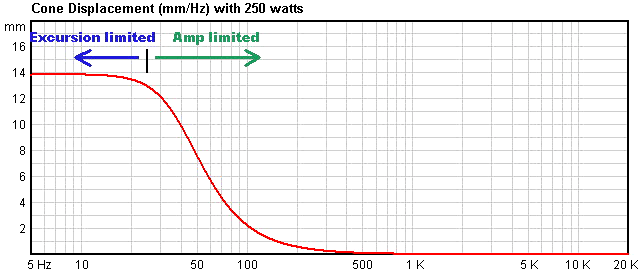
How to adjust maximum excursion using enclosure size
The most important aspect of an LT-based sub (or servo sub) is what enclosure size should be used because as we have emphasized in these subs, we would like to more precisely control the maximum excursion and leave enough excursion margin in case of amp clipping. As shown in below, the nice characteristic about using smaller enclosure and a larger amplifier is that it actually gets higher excursion utilization.

Final Comparison
In the above plot, the red line is the original plot, a 75L sealed sub driven by a 250WRMS amp. The orange plot is the same driver in a 54L sealed box driven by a 350WRMS amp. As one can see, the difference below 10 Hz is very minor and we can call it a wash. However, above 20 Hz, the brown curve has higher excursion, meaning higher SPL output. This improvement in terms of output is the key motivation to use an LT or servo-based subwoofer provided that the issue of higher corner frequency in smaller enclosures can be resolved (as it is by LT and servo designs).